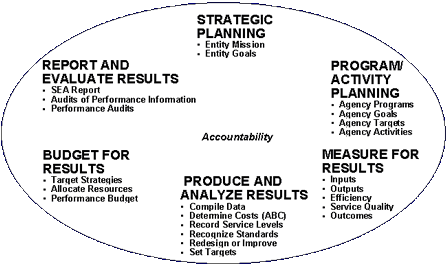
Introduction | What's New? | Managing for Results | Budgeting for Results | Accounting for Results | Auditing for Results | Courses | GASB 34 Implementation | Contact Us
|
|
MANAGING
FOR RESULTS
|
|
OVERVIEW
Last
Updated: 9-24-01
Managing for Results is a management approach that focuses on defining and then achieving the results that are important to governments. The organization develops a shared, widely understood framework using performance measurement for setting goals and objectives, managing, allocating resources and evaluating its accomplishments. Managing for Results can benefit a government by improving the focus on key results and sharpening the organization's management skills to achieve those results. It is a tool for more responsive and accountable government.
Performance Measurement Terms
The Governmental Accounting Standards Board (GASB) has recently stated that one of the objectives of financial reporting is to assist in fulfilling government's duty to be publicly accountable and to enable users to assess that accountability. Another financial reporting objective is to assist users in assessing the service efforts, costs, and accomplishments of the governmental entity. Recently, the GASB conducted a research study and issued guidance in the development, use, and reporting of service efforts and accomplishment (SEA) measures. The GASB has published an overview report entitled Service Efforts and Accomplishments Reporting: Its Time Has Come. This report defines performance measurement and applies these concepts to twelve government functions including elementary and secondary education, health, road maintenance, higher education, economic development, mass transit, police, fire, water and waste water, sanitation, hospitals, and public assistance. The GASB has issued detailed research reports for eight of the twelve functional areas. This guidance details types of performance measures as follows:
-
Input Indicators--monetary and non-monetary resources such as operating and capital dollars, full-time equivalents, equipment, and direct labor hours
-
Output Indicators--the amount of services provided such as the number of lane miles resurfaced or the tons of refuse collected
-
Efficiency Indicators--the relationship of input indicators to output or outcome indicators such as the cost per lane mile resurfaced satisfactorily or the cost per ton of refuse collected
-
Outcome Indicators--the impact on the customer such as the quality of the work performed as measured by PSI ratings for smooth streets, reduced crime, or reduced fire incidents
-
Explanatory Data--a variety of information relevant to a service that helps users to understand the factors affecting performance such as land area, population, or weather conditions.
Other performance measurement models exist, such as the use of service quality indicators, which focus on customer satisfaction, timeliness, and accuracy and workload or demand measures.
Performance Measurement as a Management Tool
A major component of the Government's performance measurement concept is using performance data for managerial purposes. This is the concept of performance management or Managing for Results. Performance management focuses on two basic questions:
-
How do you know if the government and its programs are effective?
-
How do you know if the government and its programs are efficient?
Effectiveness is the relationship of planned goals and objectives to actual outputs or outcomes achieved. By defining program and service targets and measuring the results in terms of outputs and outcomes, Government effectiveness can be measured and enhanced. Outcomes can be measured by collecting data which measure program success (or lack thereof). The data are indicators of whether or not the outcome has been met. Examples of outcomes are pavement condition indexes and pavement smoothness ratings for streets. Other measures of quality, timeliness and effectiveness include customer surveys and response time.
Efficiency is the relationship of inputs to outputs, usually expressed in terms of cost per unit or unit costs. Examples of efficiency measures are the costs to resurface a mile of street or the average cost to repair potholes. Once the input and output measures are established and performance data are obtained, greater efficiencies can be achieved by increasing the outputs, decreasing the inputs or a combination of both. Efficiency indicators also measure productivity where the inputs are measured in terms of hours.
Underlying the Government's objectives is the realization that to change the way the Government performs its business is to change how the Government's managers, supervisors and staff think about Government operations. To be successful, the Government's performance management must involve its managers, supervisors, and staff in most or all of the steps working together. In essence, performance management is the reason why performance measurement exists. The Government can measure performance in order to improve effectiveness and efficiency.
Managing For Results

A number of governments have developed or are developing strategic plans including mission and goal statements that articulate their strategic direction. Governments have several programs, which carry out the strategic direction. Programs have performance measures of input, output, outcome and efficiency that measure the achievement of various programs or activities. Should the government adopt the Managing for Results concepts, the government would compile data on the performance measures and report current service levels. This step may include activity based costing or cost accounting to determine the costs of providing programs. Once current service levels are understood, the government would analyze the extent to which current service levels are efficient or effective by comparing current service levels, including costs, to the government's performance over time (baselining) or other comparable cities (benchmarking). The government's current level of performance would be compared to its baseline, other cities, or other standards to be developed in order to perform a gap analysis. This gap analysis would identify revised targets by government programs and provide the foundation a basis from which to develop strategies to improve performance. These revised targets can then be linked to the government's budget by identifying resources needed to achieve the revised targets. Finally, performance reporting would provide internal and external reports on accomplishments including the CAFR, GPFS, the budget document, and Service Efforts and Accomplishments (SEA), balanced scorecard or other performance reporting.
Web
Design and Hosting by DREAM PURSUIT COMMUNICATIONS
Making it Simple!
www.DreamPursuit.com